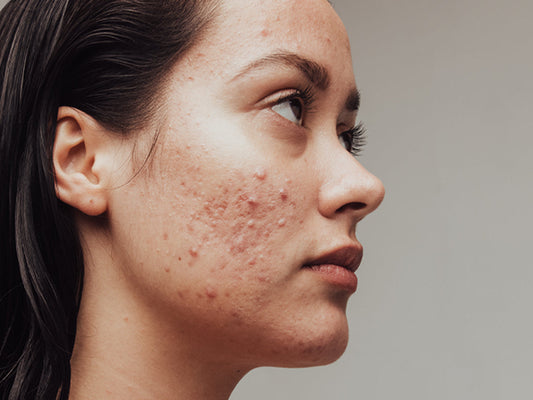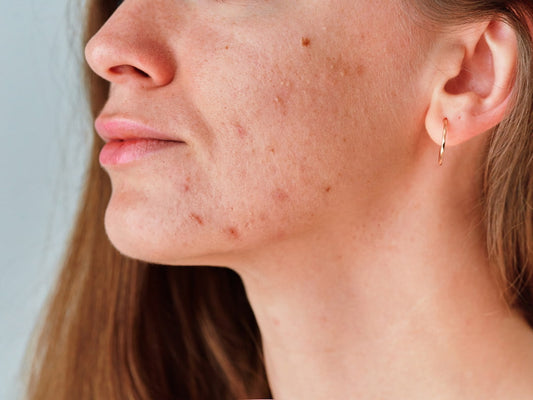What’s the difference between ‘broad-spectrum’ and ‘full-spectrum’ protection?
Published on 26 September 2023
With so many different brands and types of sunscreens available on the market today - all with different levels of protection, different formulations, and at different price points - it can be difficult to know what to look out for when choosing a sunscreen and decide which one to is right for you and your skin.
It’s largely recommended by skincare experts, that we should at minimum be wearing a sunscreen that protects against both UVA rays and UVB rays every day, as this can help to protect skin health, and prevent, and even reverse, the signs of premature skin ageing.1,2,3 The term for a sunscreen that protects against UVA and UVB rays is known as ‘broad-spectrum’ protection. However, there are other forms of light which can cause damage to our skin health – this is where ‘full-spectrum’ protection comes in. But first, let’s take a look at broad-spectrum protection in more detail.
What is broad-spectrum protection?
Broad-spectrum protection refers to protection against two forms of solar radiation – UVA and UVB. The level of protection is providing in SPF and PA+ ratings (more on this later!).
UVA, or ultraviolet A, consists of long wavelengths that penetrate past the top layer of skin – the epidermis - and into the dermis. They are largely responsible for premature skin ageing, as they cause damage to collagen and elastin in the skin, resulting in loss of firmness, fine lines, and wrinkles. They also dehydrate the skin and stimulate the production of free radicals, leading to oxidative stress and damage to the skin’s DNA. UVA makes up approximately 95% of UV rays, and contribute to approximately 85% of premature skin ageing.
UVB, or ultraviolet B, is the UV radiation that causes sunburn. It is made up of short wavelengths that penetrate the epidermis and stimulate the production of melanin. It’s also the main source responsible for vitamin D synthesis. In addition to the more immediate problems of sunburn and skin thickening, UVB exposure can lead to skin diseases such as actinic keratosis and in worst case scenarios skin cancer.
What does SPF and PA+ mean?
SPF stands for ‘Sun Protection Factor. It refers to how many minutes you can stay out in the sun before UVB radiation would take to redden your skin when using the product. So, the higher the SPF, the longer it will take for sunburn to occur. For instance, a sunscreen with SPF 50 means your skin would be protected from burning for 50 minutes longer than if you hadn’t worn any sunscreen. That’s why it’s so important to remember to reapply sunscreen regularly if you are in direct sunlight for intense or extended periods of time.
PA stands for ‘Protection Grade of UVA’. The PA+ rating system was developed in Japan and uses plus signs to indicate how well the sunscreen blocks UVA rays and the more plus signs, the higher the level of protection against UVA. Currently the highest level of PA+ protection available is PA++++, which means you are 16 times more protected against UVA rays than wearing no sunscreen.
If you see the term ‘broad-spectrum’ on a sunscreen, it means the product will protect against both these forms of solar radiation.
What is full-spectrum protection?
Full-spectrum protection takes things a step further. In addition to protecting against UVA and UVB, full-spectrum protection also provides defence against two more forms of light: visible light and infrared-A.
Visible Light (HEV/HEVL)
Visible light refers to any light that can be detected by the human eye. Visible light makes up roughly 50% of the full spectrum of light. The blue/violet band of this visible spectrum has a particularly high energy level and is known as High Energy Visible Light and is often abbreviated to HEV Light or HEVL – this includes blue light emitted from digital screens from devices such as our mobiles, computers, and TVs. It affects both the epidermis and dermis via free radicals and has been proven to be one of the main inducers of hyperpigmentation caused by sun exposure, and can also trigger erythema (inflammation of this skin such as redness and rashes).4 The effects of Visible Light on our skin are also amplified by the presence of UVA.4
Infrared-A (IR-A)
The final form of light included when we use the term ‘full-spectrum’ protection is infrared-A. This type of radiation is felt as heat, and accounts for about 40% of the solar radiation that reaches the earth’s surface. It can penetrate to the deepest layers of the skin, causing redness, inflammation, and photoageing (wrinkles and loss of elasticity, roughness, dark spots).5
Visible light and Infrared-A, along with UVA, are present all year round and can indirectly damage our skin’s DNA through oxidative stress by free radicals, contributing towards the development of skin cancer and other forms of non-melanoma skin cancer.
By opting for a sunscreen which contains ‘full-spectrum’ protection, you are giving your skin the best chance at preventing DNA damage and pre-mature skin ageing.
Why is it important to wear sunscreen every day?
All four forms of solar radiation are present all year round in some capacity. UVB is much weaker in the autumn and winter, but it is still present at low levels, and can be stronger at higher elevations and closer to equator. It can also be reflected on surfaces such as snow and ice.
UVA, visible light, and infrared-A however are as harmful in the autumn and winter as they are in the summer. UVA can penetrate cloud and glass, so it’s important to wear sunscreen even on cloudy days or when you aren’t going to be out much. It is responsible for 85% of premature skin ageing, and its presence can increase the damage caused by visible light and infrared-A.
Your best defence against daylight is to wear at minimum a broad-spectrum protection sunscreen with adequate SPF and PA+ protection, and at best, a high-level, full-spectrum protection sunscreen.
If you are already in the habit of wearing sunscreen daily in the summer months, it’s important to continue this habit in the autumn and winter for optimum daylight protection – plus a lot of sunscreens such as HELIOCARE 360° also go beyond sunscreen to provide additional benefits to skin health through the use of additional technologies and skincare ingredients.
Introducing HELIOCARE 360°
All HELIOCARE 360° daily sunscreens provide full-spectrum protection against UVB (minimum SPF50), UVA (PA++++), visible light and infrared-A, and contain intelligent ingredients to help boost skin health, including DNA repair enzymes and the supercharged antioxidant Fernblock®, - which helps to neutralises free radicals and boost skin health - as well as vitamins C, E, and Green Tea extract.
Developed by dermatologists and supported by over 80 clinical studies, HELIOCARE 360° not only provides full-spectrum protection against UVA, UVB, visible light and infrared-A but it’s unique antioxidant technology Fernblock® takes skin protection to the next level helping to:
- Protect skin against damage caused by daylight6,7,8
- Protect and repair skin cell DNA9
- Prevent light-induced pigmentation10
- Protect the skin’s immune system10
- Prevent collagen breakdown7
HELIOCARE 360° offers a wide range of daily sunscreens which offer targeted solutions for all skin types. With unique formulations designed to help prevent and reduce the symptoms of key skin concerns such as fine lines and wrinkles, pigmentation, and redness, as well as products that combine the benefits of full-spectrum daylight protection and foundation coverage, there’s a HELIOCARE 360° for everyone that you’ll love to use every day.
Find your perfect daily sunscreen and make HELIOCARE 360° part of your everyday today.



